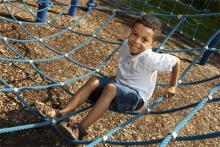
A non-rigid or “flexible” component is defined by ASTM F 1487 as: “…any part of the playground equipment, excluding swings, that temporarily changes its shape when in use; examples include the tire net, the cargo net, and the log bridge.”1
Non-rigid components are used to develop balance and coordination. They do not provide steady support as rigid climbers do and are found on play equipment designed for use by the 5-12 age group, as younger children generally have not developed these skills .
Flexible climbers can provide access to composite structures or can be freestanding. Whenever flexible climbers are used, they should be anchored securely.
If the non-rigid components have openings that allow the torso probe to enter, they must also allow the head probe to pass completely through.2

